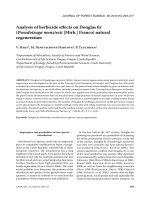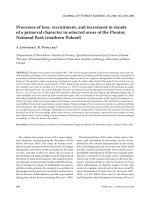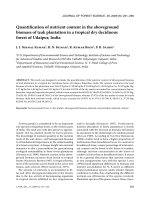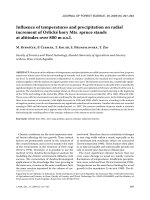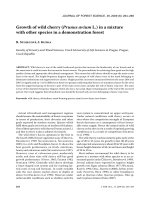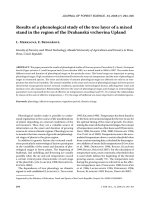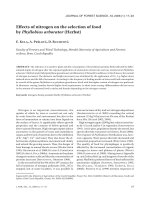Báo cáo lâm nghiệp: "Effects of a calcium deficiency on stomatal conductance and photosynthetic activity of Quercus robur seedlings grown on nutrient solution" pdf
Bạn đang xem bản rút gọn của tài liệu. Xem và tải ngay bản đầy đủ của tài liệu tại đây (802.04 KB, 11 trang )
Original
article
Effects
of
a
calcium
deficiency
on
stomatal
conductance
and
photosynthetic
activity
of
Quercus
robur seedlings
grown
on
nutrient
solution
M
Ridolfi
O Roupsard
2
JP
Garrec
E
Dreyer
1
Équipe
pollution
atmosphérique;
2
Équipe
bioclimatologie
et
écophysiologie,
unité
d’écophysiologie
forestière,
Centre
de
Nancy,
Inra,
54280
Champenoux,
France
(Received
23
November
1994;
accepted
29
June
1995)
Summary —
The
effects
of
a
calcium
deficiency
on
stomatal
functions
and
photosynthesis
were
investigated
in
Quercus
roburseedlings
grown
on a
nutrient
solution.
A
severe
calcium
deficiency
did
not
perturb
stomatal
reactivity
to
abscisic
acid,
and
stomatal
aperture
in
darkness
was
only
slightly
increased.
On
the
other
hand,
stomatal
conductance
under
full
light,
and
net
CO
2
assimilation
rates
decreased
to
one-half
of
the
controls.
A
slowdown
of
stomatal
opening
during
dark-light
transitions
was
detected
in
the
deficient
leaves.
Low
Ca2+
availabilty
could
reduce
the
light
activation
of
chloroplastic
enzymes
involved
in
organic
osmoticum
production
in
the
guard
cells.
The
reduction
of
net
CO
2
assim-
ilation
was
associated
with
a
maintenance
of
the
CO
2
mole
fraction
in
the
substomatal
spaces
and
with
a
stability
of
the
photochemical
efficiency
of
photosystem
II
(PS
II)
in
dark-adapted
leaves.
Combined
measurements
of
gas
exchange
and
photochemical
efficiency
allowed
the
computation
of
the
CO
2
mole
fraction
at
the
site
of
carboxylation
in
the
chloroplast,
which
decreased
significantly
in
the
Ca-defi-
cient
leaves.
This
result
suggests
that
a
lower
CO
2
availability
at
the
carboxylation
site
was
the
major
factor
limiting
CO
2
assimilation
under
calcium
deficiency.
calcium
deficiency
/
stomata
/
photosynthesis
/
chlorophyll
fluorescence
/
Quercus
*
Correspondence
and
reprints
Abbreviations:
A:
net
CO
2
assimilation
rate
(μmol
m
-2
s
-1);
gc,
gw:
stomatal
conductance
to
CO
2
and
to
water
vapour
(μmol
m
-2
s
-1);
ci,
cc:
CO
2
mole
fractions
in
the
substomatal
spaces
and
in
the
chloro-
plast
stroma
(μmol
mol
-1);
gm:
mesophyll
conductance
to
CO
2
(mmol
m
-2
s
-1);
PFD:
photosynthetic
pho-
ton
flux
density
(μmol
m
-2
s
-1);
PS
II:
photosystem
II;
Fv
/F
m:
maximal
photochemical
efficiency
of
PS
II
in
the
dark-adapted
state;
ΔF/F
m
’:
photochemical
efficiency
of
PS
II
in
the
light-adapted
state;
Fv
’/F
m
’:
photochemial
efficiency
of
open
PS
II
reaction
centers
in
the
light-adapted
state;
JT:
total
light
driven
electron
flow
(μmol
m
-2
s
-1);
JC,
JO:
light
driven
electron
flow
devoted
to
carboxylation
and
oxygena-
tion
of
RuBP,
respectively
(μmol
m
-2
s
-1);
ABA:
abscisic
acid;
SD:
standard
deviation.
Résumé —
Influence
d’une
carence
calcique
sur
le
fonctionnement
stomatique
et
l’activité
photosynthétique
de
plants
de
Quercus
robur
cultivés
en
solution
nutritive.
L’influence
d’une
carence
calcique
sur
le
fonctionnement
stomatique
et
la
photosynthèse
a
été
étudiée
sur
des
plants
de
Quercus
robur
cultivés
en
hydroponie.
La
carence
calcique
n’a
pas
affecté
la
réponse
des
stomates
à
l’ABA,
et
les
degrés
d’ouverture
stomatique
enregistrés
à
l’obscurité
n’étaient
que
légèrement
supé-
rieurs
à
ceux
des
plantes
témoins.
En
revanche,
les
conductances
stomatiques
en
présence
de
lumière
ainsi
que
l’assimilation
nette
de
CO
2
des
plantes
carencées
étaient
réduites
de
moitié.
De
plus,
la
vitesse
d’ouverture
des
stomates
lors
d’une
transition
obscurité-lumière
était
fortement
réduite.
La
disponibilité
en
Ca++
dans
les cellules
de
garde
pourrait
limiter
la
libération
d’osmoticum
de
type
orga-
nique
nécessaire
au
mouvement
d’ouverture.
La
diminution
de
photosynthèse
était
accompagnée
d’une
stabilité
de
la
concentration
en
CO
2
dans
les
espaces
intercellulaires,
et
du
maintien
d’une
effi-
cience
photochimique
maximale
du
PS
II
en
fin
de
nuit.
La
concentration
chloroplastique
en
CO
2,
cal-
culée
à
partir
de
mesures
combinées
d’échanges
gazeux,
et
d’efficience
photochimique
du
PS
II
par
fluorescence
de
la
chlorophylle,
était
en
revanche
significativement
plus
faible
dans
les
plantes
caren-
cées.
Ces
résultats
suggèrent
qu’une
baisse
de
la
disponibilité
en
CO
2
dans
le
chloroplaste
était
le
prin-
cipal
facteur
limitant
de
l’assimilation
nette
de
CO
2
en
situation
de
carence
calcique.
carence
calcique
/ stomate
/ photosynthèse
/ fluorescence
de
la
chlorophylle
/Quercus
INTRODUCTION
Quercus
robur
L
is
among
the
major
species
used
for
timber
production
in
western
Europe
and
is
widely
distributed
in
lowland
forests
all
over
France.
Like
many
other
oak
species,
it
suffered
from
frequent
periods
of
decline
and
crown
yellowing
(Landmann
et
al,
1993).
There
is
now
a
wide
consensus
that
drought
is
probably
the
major
factor
inducing
such
decline
processes,
in
inter-
action
with
diverse
biotic
aggressors
(Becker
and
Lévy,
1982).
However,
much
evidence
points
also
to
a
decrease
of
calcium
avail-
ability
due
to
long-term
soil
eutrophisation
in
oak
stands
(Thimonnier
et
al,
1994;
Lévy
et
al,
1995).
Furthermore,
ecological
studies
indicated
a
higher
requirement
in
soil
nutri-
ents
for
Q
roburthan
for
Q petraea,
an
other
broad-leaved
species
(Lévy
et
al,
1992).
An
analysis
of
potential
dysfunctions
induced
in
Q
roburseedlings
by
reduced
Ca2+
sup-
ply
was
therefore
undertaken.
Calcium
is
involved
in
many
physiological
processes
of
higher
plants.
High
Ca
con-
tents
occur
in
the
cell
wall,
in
association
to
pectins,
and
Ca2+
operates
as
a
second
messenger
in
the
regulation
of
diverse
metabolic
processes.
Indeed,
variations
of
cytosolic-free
Ca2+
in
guard
cells
are
thought
to
link
stomatal
movements
to
the
variations
in
environmental
conditions
(reviewed
by
Mansfield
et
al,
1990).
In
particular,
both
absisic
acid
(ABA)
and
darkness-induced
stomatal
closure
involve
Ca2+
as a
second
messenger
(De
Silva
et
al,
1985;
Schwartz,
1985;
MacRobbie,
1988;
McAinsh
et
al,
1990).
A
calcium
deficiency
may
therefore
be
suspected
to
affect
stomatal
movements
and
as
a
consequence
plant
water
status
and
CO
2
net
assimilation.
Moreover,
the
existence
of
a
light-medi-
ated
Ca2+
uptake
in
the
chloroplast
(Moore
and
Akerman,
1984;
Kreimer
et
al,
1985),
resulting
in
an
increase
in
stromal-free
Ca2+
,
suggests
that
Ca2+
acts
as a
regulatory
component
in
photosynthesis.
The
light-
mediated
activation
of
fructose-1,6-bispho-
sphatase
in
intact
spinach
chloroplasts
(Kreimer
et
al,
1988)
requires
Ca2+
influx
into
the
chloroplast.
Likewise,
evidence
for
an
activation
of
the
NAD
kinase
by
Ca2+
has
been
reported
(Moore
and
Akerman,
1984).
The
existence
of
specific
Ca2+
-bind-
ing
sites
at
photosystem
II
(PS
II)
(Barr
et
al,
1983)
indicates
additional
roles
for
Ca2+
within
the
chloroplast.
Ca2+
is
required
for
the
activity
and
the
stability
of
the
O2
-evolv
ing
complex
of
PS
II
(Mei
and
Yocum,
1992).
Light
driven
photosynthetic
reactions
might
well
be
affected
by
a
calcium
deficiency.
Thus,
it
is
of
major
importance
from
an
ecological
viewpoint
to
understand
the
role
of
calcium
nutrition
in
influencing
stomatal
behaviour
and
photosynthesis.
For
this
rea-
son
we
assessed
the
disorders
induced
by
a
reduction
of
calcium
availability
on
stom-
atal
sensitivity
to
different
stimuli
(ie,
dark-
ness,
light
and
ABA)
on
Q
robur seedlings
grown
in
a
nutrient
solution.
We
also
searched
for
a
limitation
of
CO
2
uptake
with
calcium
deficiency.
To
evaluate
the
nature
of
disorders
induced
on
photosynthetic
pro-
cesses
in
oak
leaves,
we
analysed
concur-
rently
CO
2
assimilation
rates,
stomatal
con-
ductance
and
photochemical
efficiency
of
PS
II.
Resistances
to
CO
2
influx
into
the
leaves
were
estimated
via
the
mole
frac-
tions
of
CO
2
in
the
substomatal
spaces
and
in
the
chloroplast.
Initial
and
total
carboxy-
lation
activities
of
Rubisco
were
also
tested
in
both
control
and
Ca-deficient
plants.
MATERIALS
AND
METHODS
Three-month-old
seedlings
of
Quercus
robur
L
(seed
origin:
Manoncourt,
northeast
France)
were
grown
in
a
climate
chamber
(PFD
≈ 300
μmol
m
-2
s
-1
,
RH
≈ 60%,
22 °C,
14
h
photoperiod)
on
a
nutrient
solution:
macronutrients
(mM),
0.085
NaCl,
0.54
MgSO
4
(7H
2
O),
0.276
(NH
4)2
SO
4,
1.05
Ca(NO
3)2,
1
KNO
3,
0.25
K2
HPO
4,
4.85
KH
2
PO
4;
micronutrients
(μM),
3.64
MnSO
4
H2
O,
3.06
ZnSO
4
(7H
2
O),
9.12
H3
BO
3,
0.78
CuSO
4
(5H
2
O),
0.25
MoO
7
(NH
4)2,
0.1
FeSO
4
(7H
2
O),
0.1
EDTA,
Na
2.
Calcium
deficiency
was
induced
by
suppressing
Ca(NO
3)2
of
the
solution
and
adjusting
the
NO
3
supply
with
KNO
3.
Leaves
were
dried
at
65 °C
for
48
h.
Samples
were
wet
digested
using
a
HNO
3
-HCIO
4
mixture.
Ca,
Mg
and
K
were
determined
by
atomic
absorption
spectrophotometry.
Stomatal
density
was
determined
on
six
leaves
for
both
treatments
using
a
scanning
electron
microprobe
(Cambridge
Instruments,
Cambridge,
UK).
For
each
leaf,
stomata
of
six
squares
(0.04
mm
2)
were
numerated.
The
response
of
stomata
to
exogenous
ABA
(±
2-cis,
4-trans-abscisic
acid,
Aldrich-Chemie,
Stein-
heim,
Germany)
was
monitored
on
a
leaf
of
three
plants
from
each
treatment.
A
twig
with
six
to
eight
leaves
was
cut
under
water,
and
after
stabilisation
of
stomatal
conductance,
the
shoot
was
trans-
ferred
to
a
tube
containing
an
aqueous
solution
of
ABA
(10
-3
M).
Stomatal
conductance
was
fol-
lowed
with
a
porometer
(Delta-T
Device,
MK
III,
Cambridge,
UK).
Chlorophylls
were
extracted
from
leaf
disks
(3
cm
2)
in
5
mL
of
dimethyl-sulphoxide
(DMSO)
for
90
min
at
65 °C
and
determined
spectrophoto-
metrically
(Barnes
et
al,
1992).
Initial
and
total
carboxylation
activities
of
Rubisco
were
assayed
spectrophotometrically
on
desalted
extracts
of
fresh
leaves
according
to
Van
Oosten
et
al
(1992).
Activities
were
expressed
in
nanokatal
per
mg
protein.
The
soluble
protein
content
of
the
desalted
extract
was
determined
using
the
Coomassie
blue
method
(Bradford,
1976).
The
effects
of
a
dark-light
transition
on
stom-
atal
conductance
and
photosynthesis
were
fol-
lowed
in
situ
successively
on
four
control
and
four
deficient
leaves
using
the
gas
exchange-chloro-
phyll
a
monitoring
system
described
below.
Leaf
gas
exchange
was
monitored
on
single
leaves
enclosed
in
an
aluminium
open-flow
cham-
ber
(10
cm
2,
LSC2,
ADC,
Hoddesdon,
UK).
The
drop
in
partial
pressures
of
CO
2
and
H2O
in
the
chamber
was
measured
with
a
Binos
IR
gas
anal-
yser
(Leybold
Heraeus,
Germany).
The
temper-
ature
of
the
chamber
(22.5
°C)
was
controlled
by
water
circulating
within
the
aluminium
body.
A
PFD
of
500
μmol
m
-2
s
-1
was
provided
by
a
slide
projector
(Halogen
lamp,
250
W),
and
measured
with
a
Li-Cor
Quantum-Sensor
(Li-Cor
Inc,
USA).
CO
2
entering
the
chamber
was
controlled
by
an
absolute
analyser
(Mark
II,
ADC,
Hoddesdon,
UK)
and
kept
at
350
μmol
mol
-1
using
mass
flow
con-
trollers
(FC200,
Tylan,
USA).
Leaf
to
air
water
vapour
pressure
difference
was
set
at
10
Pa
kPa
-1
.
In
parallel,
chlorophyll
a
fluorescence
(steady-state
and
light-saturated)
was
recorded
with
a
pulse
amplitude
modulated
fluorometer
(PAM
101
Walz,
Effeltrich,
Germany),
with
the
distal
end
of
the
fibre
optics
placed
at
45°
above
the
upper
leaf
surface.
Fluorescence
signals
were
used
to
compute
the
photochemical
efficiency
of
PS
II
of
dark-adapted
leaves
(F
v
/F
m
=
[F
m
/F
o
]/F
m,
Genty
et
al,
1987),
and
of
leaves
having
reached
steady-state
photosynthesis
under
a
PFD
of
500
μmol
m
-2
s
-1
(ΔF/F
m
’ =
[F
m
’-F]/F
m
’,
Genty
et
al,
1989).
Basic
fluorescence
(Fo’
)
was
recorded
immediately
after
switching
off
the
light
and
used
to
compute
photochemical
efficiency
of
open
PS
II
reaction
centres
(F
v
’/F
m
’ =
[F
m
’-F
o
’]/F
m
’,
Genty
et
al,
1989).
Net
CO
2
assimilation
rates
(A),
stom-
atal
conductance
to
CO
2
(g
c)
or
to
water
vapour
(g
w
),
and
the
substomatal
CO
2
concentration
(c
i)
were
calculated
following
the
equation
of
von
Caemmerer
and
Farquhar
(1981).
After
suitable
calibration,
fluorescence
signals
were
used
to
compute
total
light
driven
electron
flow
(J
T
),
car-
boxylation
(J
c)
and
oxygenation
(J
o)
flows
(Peter-
son,
1989;
Valentini
et
al,
1995).
These
results
were
used
to
derive
a
CO
2
concentration
in
the
chloroplast
(c
c)
using
a
Rubisco
specificity
fac-
tor
of
95
(for
details
see
Roupsard
et
al,
1996).
RESULTS
Nutrient
content
and
plant
growth
The
calcium
deficiency
in
the
nutrient
solu-
tion
promoted
a
significant
decrease
in
the
Ca2+
content
of
leaves
(fig
1):
mean
con-
centrations
fell
to
about
30%
of
the
controls
ie,
1.5
mg
gDW
-1
.
The
magnesium
content
was
lowered
to
about
60%
of
controls
but
potassium
remained
similar
in
both
cases,
with
nevertheless
a
larger
variability
among
Ca-deficient
seedlings.
No
obvious
effect
of
the
Ca2+
deficiency
was
detected
on
growth,
which
remained
in
both
cases
restricted
to
a
unique
flush.
Neither
total
leaf
area
or
number
of
leaves,
nor
seedling
height
were
reduced
(table
I).
Nevertheless,
the
Ca2+
deficiency
resulted
in
a
typical
deformation
of
the
leaf
surface
in
all
plants.
Contents
in
chlorophyll
a
and
b
were
not
affected
by
the
treatment
(table
I).
Stomatal
movements
Both
treatments
exhibited
similar
stomatal
densities
(table
I).
A
supply
of
ABA
via
the
xylem
of
control
plants
induced
a
stomatal
closure
with
two
phases,
a
fast
one
followed
by
a
slower
one
(fig
2).
Stomatal
conduc-
tance
reached
levels
around
0
after
90
min.
Ca-deficient
leaves
were
characterised
by
lower
initial
stomatal
apertures,
without
any
delay
in
the
response
to
ABA.
An
almost
complete
closure
was
recorded
after
20-30
min.
However,
Ca-deficient
leaves
did
not
present
the
second,
and
slower
closure
phase.
Under
darkness,
stomatal
conductance
to
CO
2
(g
c)
was
almost
nil
in
control
leaves
and
slightly
higher
(5-20
mmol
m
-2
s
-1
)
in
Ca-deficient
leaves
(fig
3,
table
II).
A
transi-
tion
from
darkness
to
a
PFD
of
500
μmol
m
-2
s
-1
promoted
a
fast
stomatal
opening
in
the
leaves
of
controls,
and
a
much
slower
one
in
the
Ca-deficient
with
almost
doubled
opening
half-times
(fig
3).
Steady-state
aper-
ture
was
achieved
after
20-30
min
in
light
for
control
leaves
and
only
after
40-50
min
for
Ca-deficient
plants.
Furthemore,
mean
steady-state
stomatal
conductance
was
low-
ered
by
55%
in
Ca-deficient
plants
(table
II).
Regulation
of
photosynthetic
activity
Dark
respiration
measured
at
predawn
was
almost
doubled
in
Ca-deficient
plant
(table
II).
After
the
onset
of
irradiance,
net
CO
2
assimilation
rates
(A)
increased
in
parallel
with
gc
(fig
3).
A
phase
shift
in
the
increase
of
A
was
also
recorded
in
Ca-deficient
leaves.
Likewise,
the
steady-state
value
of
A
in
Ca-deficient
plants
was
reduced
to
half
of
the
control.
A
unique
linear
relationship
was
found
between
A
and
the
stomatal
con-
ductance
to
water
vapour
(g
w)
at
steady
state
fro
both
treatments,
and
the
y-inter-
cept
was
not
significantly
different
from
zero
(fig
4).
As
a
result,
the
decrease
in
A
was
accompanied
by
the
maintenance
of
the
calculated
intercellular
CO
2
mole
fraction
(c
i)
at
about
240
μmol
mol
-1
(fig
5,
table
II).
The
predawn
photochemical
efficiency
of
PS
II
(F
v
/F
m)
remained
at
the
almost
max-
imal
value
of
0.8
in
both
control
and
Ca-
deficient
leaves
(fig
6).
Likewise,
neither
the
photochemical
efficiency
of
PS
II
in
the
light
(ΔF/F
m
’),
nor
the
photochemical
efficiency
of
open
reaction
centers
(F
v
’/F
m
’)
were
signif-
icantly
reduced
by
the
calcium
deficiency.
As
a
result,
calculated
total
light
driven
elec-
tron
flows
(J
T)
remained
constant
despite
the
reduced
net
assimilation.
The
electron
flow
devoted
to
RuBP
carboxylation
(J
C)
was
reduced
and
the
one
used
for
RuBP
oxygenation
(J
O)
was
amplified.
The
ratio
JC
/J
O
was
therefore
strongly
reduced,
yield-
ing
a
significantly
lower
calculated
CO
2
con-
centration
at
the
carboxylation
sites
(c
c)
under
calcium
deficiency:
160
versus
110
μmol
mol
-1
(P
<
0.05,
fig
5,
table
II).
We
computed
a
mesophyll
conductance
to
CO
2
(g
m)
based
on
the
oversimplified
model
gm
=
A
/
(c
i
-c
c
),
and
observed
that
it
decreased
significantly
in
the
Ca-deficient
plants
(100
versus
40
mmol
m
-2
s
-1
,
P <
0.05,
fig
5).
The
initial
carboxylation
activity
of
Rubisco
was
high
in
control
plants
and
close
to
total
activity
(activation
state:
97%,
fig
7).
The
Ca-deficiency
resulted
in
a
significant
decrease
of
the
initial
carboxylation
activ-
ity
(P
<
0.05),
while
the
total
activity
of
the
enzyme
was
not
affected
(fig
7).
The
acti-
vation
state
of
Rubisco
was
therefore
reduced
to
80%
of
controls.
DISCUSSION
The
suppression
of
Ca2+
in
the
nutrient
solu-
tion
resulted
in
a
very
significant
decrease
in
Ca
and
Mg
contents
in
the
leaves
of
Quer-
cus
roburseedlings:
1.5
versus
5
and
2
ver-
sus
3.4
mg
gDW
-1
,
respectively.
These
residual
amounts
were
probably
mobilized
from
the
cotyledons.
Deficiency
thresholds
of leaf
content
in
Mg
are
thought
to
be
around
1
and
below
5
mg
gDW
-1
for
Ca
(Bonneau,
1988).
A
national
survey
of
oak
forests
in
France
showed
that
in
adult
trees,
contents
in
Mg
and
Ca
ranged
between
1.1
and
2.5
and
5.9
and
11.2
mg
gDW
-1
,
respectively
(Ulrich
and
Bonneau,
1994).
We
may
therefore
assume
that
the
seedlings
presented
a
strong
deficiency
in
Ca,
while
Mg
remained
above
deficiency
levels.
The
observed
stability
of
chlorophyll
concentrations
was
a
good
confirmation
of
an
almost
adequate
Mg
content.
Stomata
play
a key
role
in
regulating
the
influx
of
carbon
dioxide
and
the
loss
of
water
vapour.
Cytosolic-free
Ca2+
is
thought
to
be
involved
in
signal
transduction
linking
the
variations
in
environmental
conditions
to
stomatal
movements
(reviewed
by
Mans-
field
et
al,
1990).
Thus,
darkness
(Schwartz,
1985)
and
ABA
(De
Silva
et
al,
1985;
Mc
Ainsh
et
al,
1990)
induce
stomatal
closure
mainly
via
an
increase
of
cytosolic-free
Ca2+
in
the
guard
cells,
which
in
turn
inhibits
pro-
ton
efflux
(Inoue
and
Katoh,
1987)
and
K+
uptake
(Blatt
et
al,
1990),
and
activates
anion
efflux
(Schroeder
and
Hagiwara,
1989).
The
calcium
deficiency
in
oak
leaves
resulted
in
an
uncomplete
stomatal
closure
under
darkness.
Thus,
we
may
state
that
decreased
availability
of
calcium
at
leaf
level
probably
affected
the
pool
of
guard
cell
Ca2+
and
therefore
limited
the
increase
in
cytoso-
lic
Ca2+
necessary
for
the
dark-induced
stomatal
closure.
On
the
other
hand,
the
stomatal
reactivity
to
ABA,
the
endogenous
growth
regulator
which
is
thought
to
link
stomatal
responses
to
water
deficit
(Davies
and
Zhang,
1991),
was
not
modified
and
a
complete
stomatal
closure
was
always
recorded
30
min
after
ABA
supply.
A
similar
discrepancy
between
the
perception
by
guard
cells
of
darkness
versus
ABA
as
the
result of
calcium
deficiency
has
been
pre-
viously
described
in
Vicia
faba
(Ridolfi
et
al,
1994).
ABA
supply
induced
a
partial
stom-
atal-closing
movement
in
Ca-
deficient
V
faba
plants,
whereas
darkness
had
no
effect
at
all
(completely
open
stomata).
Such
effects
could
be
related
to
the
fact
that
dark-
ness-induced
stomatal
closure
relies
on
an
increase
in
cytosolic
Ca2+
,
while
ABA-
induced
closure
could
also
involve
Ca2+
-
independent
transduction
pathways
(Gilroy
et al,
1991).
The
Ca
deficiency
resulted
in
an
increase
of
the
half-times
for
stomatal
opening
from
7.7
to
21.7
min.
The
values
recorded
for
the
control
oak
seedlings
agreed
rather
well
with
published
data
(around
12
min
for
Phaseolus,
Barradas
et
al,
1994;
24
min
for
Commelina
communis,
Vavasseur
et
al,
1984;
35
min
for
Vicia
faba,
Ridolfi
et
al,
1994).
Water
stress,
increased
temperature
and
vapour
pressure
deficits
were
found
to
decrease
this
half-time
in
Phaseolus
vul-
garis
(Barradas
et
al,
1994).
We
do
not
know
of
any
further
report
indicating
changes
in
opening
half-times
in
situ
in
response
to
environmental
constraints.
In
addition
to
this
delay
in
opening,
stom-
atal
aperture
at
steady
state
was
much
lower
in
Ca-deficient
leaves.
Both
effects
were
not
completely
expected.
Indeed,
a
decreased
availability
of
Ca2+
in
the
guard
cell
cytosol
should
not
directly
affect
the
velocity
or
the
magnitude
of
light-induced
opening,
which
generally
rely
on a
strong
influx
of
K+.
Nevertheless,
we
have
to
con-
sider
recent
studies
on
epidermal
peels
or
in
intact
leaves
of
K-deficient V
faba
plants
showing
that
K+
uptake
into
guard
cell
vac-
uoles
was
not
always
necessary
to
allow
a
normal
stomatal
opening
(Poffenroth
et
al,
1992;
Ridolfi
et
al,
1994).
The
increase
in
osmotic
potential
allowing
stomatal
open-
ing
is
the
result
of
three
key
metabolic
pro-
cesses
which
do
not
always
act
together:
i)
uptake
of
K+,
balanced
by
chloride
and
malate;
ii)
accumulation
of
sucrose
through
photosynthetic
carbon
fixation;
and
iii)
accu-
mulation
of
sucrose
derived
from
starch
breakdown
(Tallman
and
Zeiger,
1988;
Pof-
fenroth
et
al,
1992;
Talbott
and
Zeiger,
1993).
The
deficiency
induced
a
decrease
in
net
CO
2
assimilation
(A)
at
leaf
level
to
one-
half
of
the
controls.
Rubisco
and
photosyn-
thetic
carbon
reduction
pathway
enzyme
activities
have
been
detected
in
V faba
guard
cells
(Zemel
and
Gepstein,
1985;
Shi-
mazaki
et
al,
1989).
It
can
be
envisioned
that
calcium
deficiency
also
reduced
the
photosynthetic
carbon
fixation
in
guard
cells.
As
a
result,
the
amount
of
soluble
sugars
(glucose,
fructose)
required
for
the
osmotic
buildup
might
have
been
lowered
and
con-
sequently
have
reduced
stomatal
aperture
in
light.
With
regard
to
net
CO
2
assimilation
rates
at
leaf
level,
reductions
in
A
can
be
the
result
of
reduced
CO
2
influx
or
changes
in
meso-
phyll
capacity
for
photosynthesis.
Recently,
combined
measurements
of
gas
exchange
and
of
quantum
yield
of
light
conversion
by
PS
II
with
chlorophyll
a
fluo-
rescence,
showed
that
the
influx
of
CO
2
from
substomatal
spaces
to
chloroplast
stroma
(including
gas
diffusion
and
liquid
phase
fluxes)
was
an
important
limiting
step
for
photosynthesis
in
many
tree
species
(Loreto
et
al,
1992 ;
Epron
et
al,
1995;
Roup-
sard
et
al,
1996).
Calcium
deficiency
in
oak
leaves
induced
a
decrease
in
A
with
main-
tenance
of
CO
2
concentrations
in
the
sub-
stomatal
spaces
(c
i)
and
a
decrease
of
CO
2
at
the
carboxylation
sites
(c
c
).
In
contrast,
the
activation
state
of
Rubisco
was
reduced
to
80%.
We
may
exclude
an
effect
of
Mg
availability
to
explain
this
decrease
as
Mg
remained
above
the
threshold
levels.
A
sec-
ondary
effect
of
CO
2
deprivation
on
activa-
tion
state
may
be
more
probable.
Our
observations
suggest
that
the
decrease
of
CO
2
concentration
in
the
chloro-
plast
(c
c)
was
the
major
factor
limiting
A
in
Ca-deficient
plants.
Moreover,
the
stability
of
the
CO
2
concentration
in
the
substomatal
spaces
would
indicate
a
limitation
of
CO
2
influx
from
substomatal
spaces
till
chloro-
plast
stroma
(reduced
internal
conductance
to
CO
2
).
Similar
results
have
been
obtained
with
plants
submitted
to
drought
(Tourneux
and
Peltier,
1995;
Roupsard
et
al,
1996).
No
hypothesis
about
the
physiological
mech-
anisms
relating
Ca-deficiency
and
internal
conductance
to
CO
2
can
yet
be
formulated.
Moreover,
artefacts
in
the
computation
of
ci
like
those
reported
by
Terashima
et
al
(1988)
with
ABA-fed
or
water-stressed
leaves
cannot
be
completely
ruled
out
in
this
case.
Additionnal
results
would
be
needed
to
firmly
establish
the
existence
of
such
nonstomatal
limitations
in
CO
2
influx
as
a
response
to
changing
levels
of
Ca.
Inter-
estingly,
the
observed
effects
on
cc
were
obtained
while
the
intrinsinc
water
use
effi-
ciency
(A/g
w
ratio)
was
kept
constant,
under-
lining
the
good
coordination
between
reduc-
tions
of
net
assimilation
rates
and
stomatal
conductance.
A
few
ecological
consequences
of
these
findings
may
be
drawn.
As
this
severe
cal-
cium
deficiency
did
not
perturb
significantly
stomatal
reactivity
to
ABA,
and
stomatal
aperture
in
darkness
was
only
slightly
increased,
stomata
should
still
be
able
to
close
in
response
to
soil
water
depletion.
Direct
correlation
between
drought-induced
decline
processes
and
Ca
deficiency
may
be
excluded.
On
the
other
hand,
reduced
stomatal
conductance
in
light
and
declining
CO
2
uptake
lead
to
reductions
in
tree
growth.
Further
data
are
needed
to
firmly
establish
the
relationships
existing
between
the
known
effects
of
Ca2+
on
the
regulation
of
individual
metabolic
steps,
and
their
con-
sequences
for
photosynthesis
and
water
relations
at
an
integrated
leaf
level.
ACKNOWLEDGMENTS
The
authors
thank
Prof
Van
Praag
for
having
per-
formed
Ca,
K
and
Mg
quantitations
in
his
labo-
ratory,
and
Prof
Dizengremel
for
allowing
access
to
the
facilities
for
measuring
Rubisco
activity.
REFERENCES
Atkinson
CJ
(1991)
The
flux
and
distribution of
xylem
sap
calcium
to
adaxial
and
abaxial
epidermal
tissue
in
relation
to
stomatal
behaviour.
J
Exp
Bot 42,
987-
993
Atkinson
JC,
Mansfield
TA,
Kean
AM,
Davies
WJ
(1989)
Control
of
stomatal
aperture
by
calcium
in
isolated
epidermal
tissue
and whole
leaves
of
Commelina
communis
L.
New
Phytol 111,
9-17
Atkinson
JC,
Mansfield
TA,
Davies
WJ
(1990)
Does
cal-
cium
in
xylem
sap
regulate
stomatal
behaviour?
New
Phytol 116, 19-27
Balaguer
L,
Afif
D,
Dizengremel
P,
Dreyer
E
(1996)
Ribu-
lose
bisphosphate
carboxylase/oxygenase
in
an
oak
species
(Quercus
robur L):
specificity
and
activities.
Plant
Physiol
Biochem
(in
press)
Barnes
JD,
Balaguer
L,
Manrique
E,
Elvira
S,
Davison
AW
(1992)
A
reappraisal
of
the
use
of
DMSO
for
the
extraction
and
determination
of
chlorophylls-a
and
chlorophylls-b
in
lichens
and
higher
plants.
Environ
Exp
Bot
32,
85-100
Barr
R,
Troxel
KS,
Crane
FL
(1983)
A
calcium-selec-
tive
site
in
photosystem
II
of
spinach
chloroplasts.
Plant Physiol 73,
309-315
Barradas
VL,
Jones
HG,
Clark
JA
(1994)
Stomatal
responses
to
changing
irradiance
in
Phaseolus
vul-
garis
L.
J
Exp
Bot 45,
931-936
Becker
M,
Levy
G
(1982)
Le
dépérissement
du
chêne
en
Forêt
de
Tronçais.
Les
causes
écologiques.
Ann
Sci
For
39,
439-444
Blatt
MR,
Thiel
G,
Trentham
DR
(1990)
Reversible
inac-
tivation
of
K+
channels
of
Vicia
faba
stomatal
guard
cells
following
the
photolysis
of
caged
inositol
1,4,5-
triphosphate.
Nature
346,
766-769
Bonneau
M
(1988)
Le
diagnostic
foliaire.
Rev For Fr 19-
28
Bradford
MM
(1976)
A
rapid
and
sensitive
method
for
the
quantification
of
microgram
quantities
of
protein
utilizing
the
principle
of
protein-dye
binding.
Anal
Biochem72, 248-254
Davies
WJ,
Zhang
J
(1991)
Roots
signals
and
the
reg-
ulation
of
growth
and
development
of
plants
in
dry-
ing
soil.
Annu Rev
Plant
Physiol 42,
55-76
De
Silva
DLR,
Cox
RC,
Hetherington
AM,
Mansfield
TA
(1985)
Suggested
involvement
of
calcium
and
calmodulin
in
the
responses
of
stomata
to
abscisic
acid.
New
Phytol 101,
555-563
Epron
D,
Godard
D,
Cornic
G,
Genty
B
(1995)
Limitations
of
net
CO
2
assimilation
rates
by
internal
resistances
to
CO
2
transfer
in
leaves
of
two
species
(Fagus
syl-
vatica
L
and
Castanea
sativa
Mill).
Plant
Cell
Environ
18, 43-51
Genty
B,
Briantais
JM,
Viera
da
Silva
JB
(1987)
Effects
of
drought
on
primary
photosynthetic
processes
of
cotton
leaves.
Plant
Physiol 83,
360-364
Genty
B,
Briantais
JM,
Baker
NR
(1989)
The
relationship
between
the
quantum
yield
of
photosynthetic
electron
transport
and
quenching
of
chlorophyll
fluorescence.
Biochem
Biophys
Acta
990, 87-92
Gilroy
S,
Fricker
MD,
Read
ND,
Trewavas
AJ
(1991)
Role
of
calcium
in
signal
transduction
of
Commelina
guard
cells. Plant
Cell 3, 333-344
Inoue
H,
Katoh
Y
(1987)
Calcium
inhibits
ion-stimulated
stomatal
opening
in
epidermal
strips
of
Commelina
communis
L.
J
Exp
Bot
38,
142-149
Kreimer
G,
Melkonian
M,
Holtum
JAM,
Latzko
E
(1985)
Characterization
of
calcium
fluxes
across
the
envelope
of
intact
spinash
chloroplasts.
Planta
166,
515-523.
Kreimer
G,
Melkonian
M,
Holtum
JAM,
Latzo
E
(1988)
Stromal
free
calcium
concentration
and
light-medi-
ated
activation
of
chloroplast
fructose-1,6-bisphos-
phatase.
Plant
Physiol 86,
423-428
Landmann
G,
Becker
M,
Delatour
C,
Dreyer
E,
Dupouey
JL
(1993)
Oak dieback
in
France:
historical
and
recent
records,
possible
causes,
current
investigations.
Rungespräche
der
Kommission
für
Ökologie,
"Zus-
tand
und
Gefährdung
des
Laubwälder"
5,
97-114
Lévy
G,
Becker
M,
Duhamel
(1992)
A
comparison
of
the
ecology
of
pedunculate
and
sessile
oaks:
radial
growth
in
the
Center
and
the
North-West
of
France.
For
Ecol
Manage
55,
51-63
Loreto
F,
Harley
PC,
Di
Marco
G,
Sharkey
TD
(1992)
Estimation
of
mesophyll
conductance
to
CO
2
flux
by
three
different
methods.
Plant
Physiol 98,
1437-1443
MacRobbie
EAC
(1988)
Control
of
ion
fluxes
in
stom-
atal
guard
cells.
Bot Acta 101, 140-148
Mansfield
TA,
Hetherington
AM,
Atkinson
CJ
(1990)
Some
current
aspects
of
stomatal
physiology.
Annu
Rev
Plant
Physiol
Plant
Mol
Biol 41,
55-75
McAinsh
MR,
Brownlee
C,
Hetherington
AM
(1990)
Abscisic
acid-induced
elevation
of
guard
cell
cytosolic
Ca2+
precedes
stomatal
closure.
Nature
343, 186-188
Mei
R,
Yocum
CF
(1992)
Comparative
properties
of
hydroquinone
and
hydroxylamine
reaction
of
the
Ca2+
-stabilized
O2
-evolving
complex
of
Photosys-
tem
II:
reductant-dependent
Mn2+
formation
and
activity
inhibition.
Biochem
31, 8449-8454
Moore
A,
Akerman
EO
(1984)
Calcium
and
plant
organelles.
Plant
Cell
Environ 7, 423-429
Peterson
RB
(1989)
Partitioning
of
non-cyclic
photo-
synthetic
electron
transport
to
O2
-dependent
dissi-
pative
processes
as
probed
by
fluorescence
and
CO
2
exchange.
Plant
Physiol 90,
1322-1328
Poffenroth
M,
Green
DB,
Tallman
G
(1992)
Sugar
con-
centrations
in
guard
cells
of
Vicia
faba
illuminated
with
red
or
blue
light.
Plant
Physiol 98,
1460-1471
Ridolfi
M,
Garrec
JP,
Louguet
P,
Laffray
D
(1994)
Effects
of
potassium
and
calcium
deficiencies
on
stomatal
functioning
in
intact
leaves
of
Vicia
faba
L.
Can
J
Bot 72, 1835-1842
Roupsard
O,
Gross
P,
Dreyer
E
(1996)
Limitation
of
photosynthetic
activity
by
CO
2
availability
in
the
chloroplasts
of
oak
leaves
from
differents
species
and
during
drought.
Ann
Sci For 53,
243-254
Schroeder
JI,
Hagiwara
S
(1989)
Cytosolic
calcium
reg-
ulates
ion
channels
in
the
plasma
membrane
of
Vicia
faba
guard
cells.
Nature
338, 427-430
Schwartz
A
(1985)
Role
of
Ca2+
and
EGTA
on
stom-
atal
movements
in
Commelina
communis
L.
Plant
Physiol 79,
1003-1005
Shimazaki
K,
Terada
J,
Tanaka
K,
Kondo
N
(1989)
Calvin-Benson
cycle
enzymes
in
guard
cell
proto-
plasts
from
Vicia
faba
L.
Plant
Physiol 90,
1057-1064
Talbott
LD,
Zeiger
E
(1993)
Sugar
and
organic
acid
accumulation
in
guard
cells
of
Vicia
faba
in
response
to
red
and
blue
light.
Plant
Physiol 102,
1163-1169
Tallman
G,
Zeiger
E
(1988)
Light
quality
and
osmoregu-
lation
in
Vicia
guard
cells.
Plant
Physiol 88, 887-895
Terashima
I,
Wong
SC,
Osmond
CB,
Farquhar
GD
(1988)
Characterization
of
non-uniform
photosyn-
thesis
induced
by
abscisic acid
in
the
leaves
having
different
mesophyll
anatomies.
Plant
Cell
Physiol
29, 385-395
Thimonier
A,
Dupouey
JL,
Bost
F,
Becker
M
(1994)
Simultaneous
eutropication
and
acidification
of
a
for-
est
ecosystem
in
North
East
France.
New
Phytol
126, 533-539
Tourneux
C,
Peltier
G
(1995)
Effect
of
water
deficit
on
the
photosynthetic
oxygen
exchange
measured
using
18
O2
and
mass
flow
spectrometry
in
Solanum
tubero-
sum.
Planta
195,
570-577
Ulrich
E,
Bonneau
M
(1994)
État
nutritionnel
des
peu-
plements
du
réseau
RENECOFOR :
brève
synthèse
de
la
premiere
année
d’échantillonnage
et
d’anal-
yse
(1993).
In :
La
Santé
des
forêts
(France)
en
1993,
ministère
de
l’Agiculture
et
de
la
Pêche
(DERF-
Département
de
la
santé
des
forêts).
120
p
Valentini
R,
Epron
D,
De Angelis
P,
Matteucci
G,
Dreyer
E
(1995)
In
situ
estimation
of
net
CO
2
assimilation,
photosynthetic
electron flow
and
photorespiration
in
Turkey
oak
(Q
cerris
L)
leaves:
diurnal
cycles
under
different
levels
of
water
supply.
Plant
Cell
Environ
18, 631-640
Van
Oosten
JJ,
Afif
D,
Dizengremel
P
(1992)
Long-term
effects
of
a
CO
2
enriched
atmosphere
on
enzymes
of
the
primary
carbon
metabolism
of
spruce
trees.
Plant
Physiol
Biochem
30,
541-547
Vavasseur
A,
Garrec
JP,
Laffray
D
(1984)
Electronic
microprobe
study
of
variations
in
potassium
con-
centration
of
stomatal
complexes
of
two
Commeli-
naceae
Physiol
Vég 22,
841-849
von
Caemmerer
S,
Farquhar
GD
(1981)
Some
rela-
tionships
between
the
biochemistry
of
photosynthe-
sis
and
the
gas
exchange
of
leaves.
Planta
153,
376-387
Zemel
E,
Gepstein
S
(1985)
Immunological
evidence
for
the
presence
of
ribulose
bisphosphate
carboxy-
lase
in
guard
cell
chloroplasts.
Plant
Physiol 78,
586-
590

